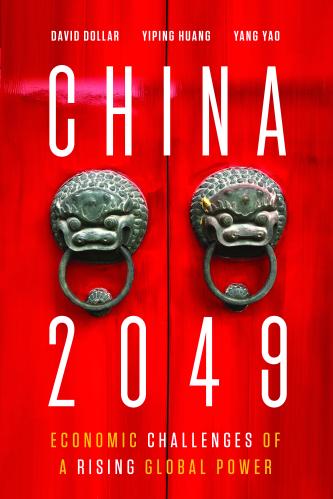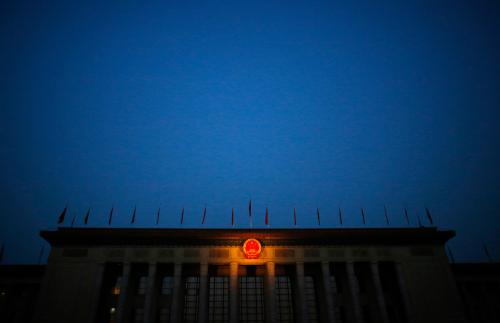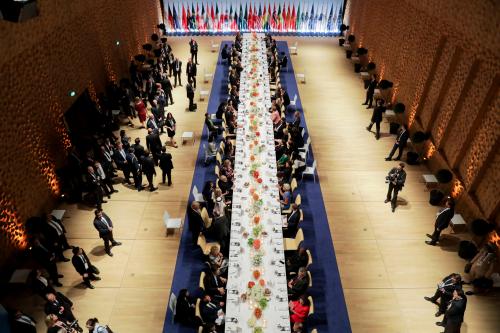If China continues to open and reform, it will probably gradually converge on the living standards of the U.S. and achieve its goal of becoming moderately well-off by 2049. There is tremendous uncertainty about the lasting impact of the COVID-19 pandemic; it may well lead to some countries backing away from globalization and to a slowing of growth everywhere.
But we think that it is not likely to overturn the persistent pattern in which less-developed economies that pursue integration with the global economy grow faster than rich countries and tend to catch up, at least partially. In fact, we believe that many reforms in China — reforms that we detail in our recent book, “China 2049: Economic Challenges of a Rising Global Power” — are more pressing in the wake of the pandemic. Three good examples are the challenges of aging in a system with strong rural-urban cleavages, inefficiencies and risks in the financial system, and the need to reform and modernize the international economic architecture.
Aging and spacial divides
Rapid aging is probably the single biggest challenge that China faces domestically. The Chinese population over 65 will increase from about 200 million today to 400 million by 2049, while the overall population declines slightly. Within this group, the most rapid rise will be the population that’s 85 and older: from fewer than 50 million today to more than 150 million in 2049.
Taking care of the elderly would be a challenge under any situation, but the challenge is compounded by rural-urban divides. Most of the elderly live in the countryside, though often their working-aged children have moved to cities as migrant workers (and frequently leaving school-aged children behind). Rural health systems are weak compared to urban ones, so taking care of the elderly will require a combination of more permanent migration to cities plus strengthened rural service delivery. It is time for China to completely scrap the registration system that limits permanent migration and to unify rural and urban pensions, health insurance, and educational systems.
Dealing well with aging is first and foremost a social issue. But it also has economic implications. As China’s workforce shrinks, the 55-64 year-old cohort will increase dramatically. Keeping this group and the “young olds” (age 65-85) healthy and active is China’s best hope for staving off dramatic labor force decline. Improving rural education is also critical because about half the workers of the future are going to school in the countryside, and deficiencies in their education will affect China’s growth for years to come.
This is the perfect time to dramatically expand public resources to address weaknesses in the safety net.
What is the relation to the COVID-19 pandemic? There is a lot of uncertainty right now, but probably even under the best scenario people will be slow to return to old consumption habits — fearful of travel and large crowds. There will be some return towards normalcy, but likely still a big shortfall in private consumption. This is the perfect time to dramatically expand public resources to address weaknesses in the safety net. As China spends more money to stimulate its economy, these would all be good areas of focus. Among other things, this will provide insurance against future pandemics.
China’s financial system
A second domestic weakness that China needs to address if it is to grow well is the financial system. It has adequately invested resources during its rapid growth phase, but the state-dominated system is inefficient. Now that China has reached middle-income status, it will need to depend less on investment and more on innovation and productivity growth. But the bank-dominated financial system favors lending to state enterprises, which have lower productivity and are less innovative than the private sector. One piece of evidence that the old investment-heavy growth model is running out of steam is that the debt-to-GDP ratio has been rising inexorably since the 2008-2009 global financial crisis. If lending is financing productive investment and growth, then this ratio should be stable or slowly rising. The rapid rise since 2009 is an indication that many poor investments are being financed.
As the pandemic devastates the economy, it is rational for the government to borrow whatever it takes to prevent a depression. But as China recovers, it will be even more important to reform the financial system because risks will inevitably increase during this stimulus period. The playbook for financial reform is well-known: Carefully introduce more flexibility into interest rates and the exchange rate; license more private financial institutions, both foreign and domestic; and turn to capital account liberalization last as this is the most difficult.
The international economic environment
China’s ability to meet its social and economic goals will also depend on the international environment and economic architecture. Before the pandemic arrived, we wrote that there are serious weaknesses in this architecture, and the pandemic has showed this in spades. The World Trade Organization is not equipped to deal with modern trade issues such as intellectual property right protection, investment restrictions, cross-border data flows, and subsidies. The major economies of the world cannot agree on expanding the resources of the International Monetary Fund because the U.S. does not want to increase the weight of China and other emerging markets in decisionmaking, though China’s growing role in the world economy should dictate otherwise. Meanwhile, the U.S. has withdrawn from the Paris Accord; China and Western donors have separate and competing programs to finance infrastructure in the developing world; and most glaringly in the current situation, the World Health Organization needs to be strengthened, not weakened.
For the world economy to function smoothly, these institutions that provide critical global public goods must be strengthened. This will require practical compromises between China and the U.S., and more generally between developing and advanced countries. Right now it seems like a (bad) joke to talk about practical compromises between China and the U.S., as the two hurl accusations across the Pacific. But we should not take it for granted that China and the U.S. will become enemies. Both countries have an interest in international cooperation on public goods. For China, we recommend unilateral further trade and investment liberalization — good for China, and a goodwill gesture in the current environment. The U.S. may go down the dead-end path of protectionism and isolation for a while, but we expect it to come back to internationalism because that is the best foundation for prosperity and peace.






Commentary
The COVID-19 recession is a good time to accelerate Chinese reform
July 7, 2020